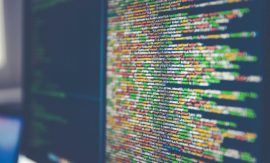Intended learning outcomes: Differentiate between things that have changed and things that have not changed since the introduction of data processing. Describe the use of the Hollerith system at operational level.
Software as a technology first gained acceptance in the late 1950s, as soon as data could be stored on suitable media, rather than having to “plug in” the computer programs every time they were used. During this period, the computer world was dominated by a single company — IBM (International Business Machines).
IBM was founded by an American named Hollerith who had introduced a system to classify the data obtained from the American census in the second decade of the twentieth century. This was based on light and electrical circuits (and subsequently electronic circuits). It was also the origin of the term “electronic data processing.” The medium used to store the data was the famous punched card. The way in which information was encoded on a punched card was a clever invention, as were the machines for punching and then reading the punched card. Essentially, every character (or “byte”), whether it was a letter, number, or special character, was assigned a unique sequence of six holes. The two states, “hole” or “no hole,” thus formed the smallest unit of information — a binary number (0 or 1) known as a “bit.” This sequence of 6 bits could be combined in 26 = 64 different ways, enabling 64 different characters to be represented (which had to include the control characters for processing). Figure 9.1.1.1 shows an extract translated from Hollerith-Mitteilungen (Hollerith News), 1913 ([IBM83], translated by the author). The reference list shows that the system had also quickly gained wide acceptance in Europe because of its ability to perform logistics tasks within a company. The “Hollerith variations” show two possible applications. The second example also directly highlights implicitly an important problem associated with data processing, that is, data protection.
Right from the start, Hollerith’s idea was intended to process large quantities of data quickly and accurately. This saved an incredible amount of time, resulting in greater productivity and ultimately a new industrial revolution. The basic idea was perfected over the following decades. For example, the character code was extended from 6 to 7 or 8 bits, that is, 256 possible combinations per byte (ASCII[note 901] or EBCDIC[note 902] code) so that lowercase and special characters could be included. The hole in the card was gradually replaced by a two-digit state on a magnetic disk or tape, which resulted in the development of suitable searching and reading devices.
Since the introduction of data processing in the early years of the twentieth century, the quantity and the speed of the processed data have increased dramatically. However, the logical principle used to display and process information and the conditions for IT support of an information system (see the introduction of this chapter 9) have not changed at all.
These facts are important if we are to understand the possibilities and limitations of data processing. This ingenious idea combined with Hollerith’s business sense enabled IBM to hold the monopoly of the commercial use of this technology for many years. The early ERP software also originated from IBM. Copics (Communication-Oriented Production Information and Control System) was the most well-known standard software package of the 1960s, and for a long time was the standard for further developments in this field. See also [IBM81]. This software was designed, in particular, to meet the needs of the major industries of that period — mechanical engineering and automobile construction.
Fig. 9.1.1.1 Early software: use of the Hollerith system at operational level.
Course section 9.1: Subsections and their intended learning outcomes

9.1 Software in the Area of ERP and SCM: An Introduction
Intended learning outcomes: Produce an overview on history and origin of ERP software. Disclose scope and range of ERP and SCM software.

9.1.1 History and Origin of ERP Software
Intended learning outcomes: Differentiate between things that have changed and things that have not changed since the introduction of data processing. Describe the use of the Hollerith system at operational level.

9.1.2 Scope and Range of ERP Software and SCM Software
Intended learning outcomes: Disclose issues and challenges of ERP software and SCM software throughout the last decades.
